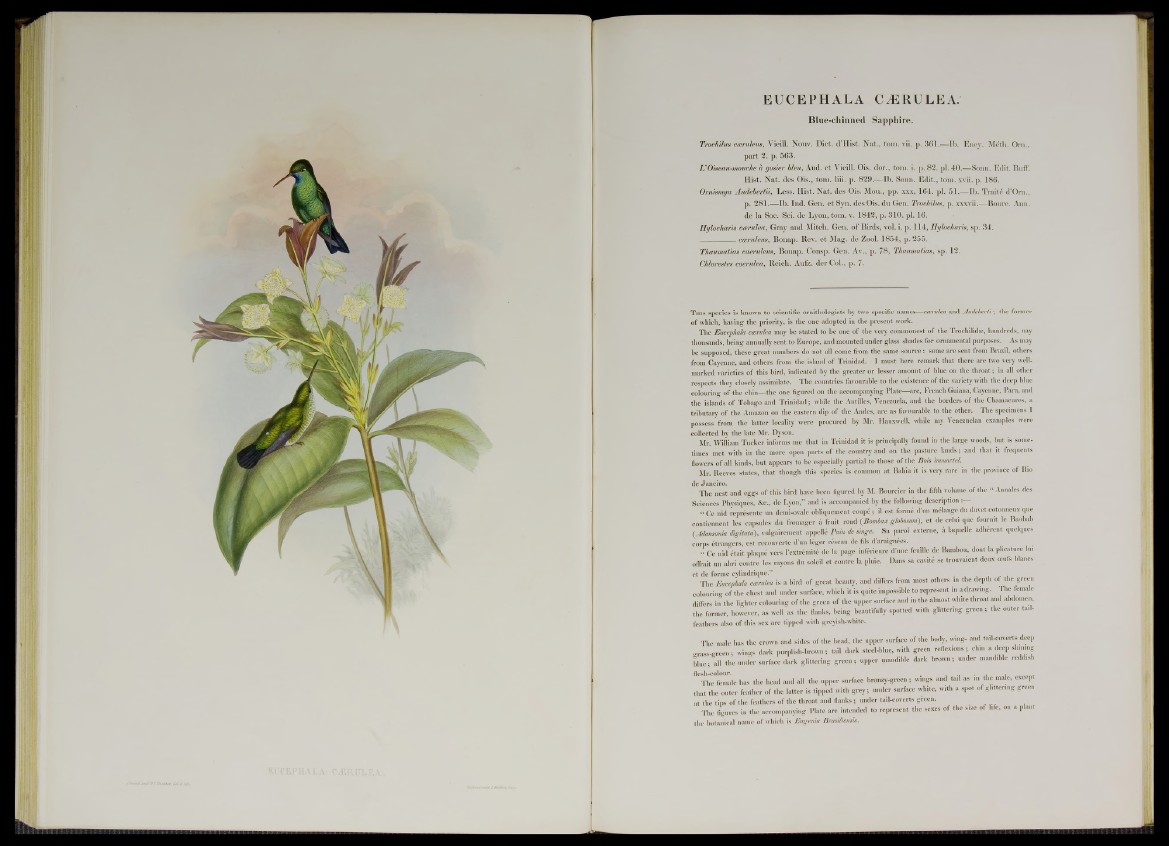
EUCEPHALA CÆRULEA.
Blue-chinned Sapphire.
TrocMlus coenileus, Vieill. Nouv. Diet. d’Hist. Nat., tom. vii. p. 361.— lb . Ency. Méth. Orn.,
p a rt 2. p. 563.
L 'Oiseau-mouche à gosier bleu, Aud. e t Vieill. Ois. dor., tom. i. p. 82. pi. 40.— Sonn. Edit. Buff.
Hist. N at. des Ois., tom. liii. p. 829.— lb . Sonn. Edit., tom. xvii. p. 186.
Ornismya Audebertii, Less. Hist. N a t. des Ois. Mou., pp. xxx, 164. pi. 51.—lb . Traité d’Om.,
p. 281,— lb . Ind. Gen. e tS y n . desOis. du Gen. Trochilus, p. xxx vii.— Bourc. Ann.
de la Soc. Sci. de Lyon, tom. v. 1842, p. 310. pi. 16.
Hylocharis cterulea, Gray and Mitch. Gen. o f Birds, vol. i. p. 114, Hylocharis, sp. 34.
__________coeruleus, Bonap. Rev. e t Mag. de Zool. 1854, p. 255.
Thaumatias caeruleus, Bonap. Consp. Gen. Av., p. 78, Thaumatias, sp. 12.
Chlorestes coenilea, Reich. Aufz. der Col., p. 7.
This species is known to scientific ornithologists by two specific names—cterulea and Audeberti ; the former
of which, having the priority, is the one adopted in the present work.
The Encephala cterulea may be stated to be one of the very commonest of the Trochilidæ, hundreds, nay
thousands, being annually sent to Europe, and mounted under glass shades for ornamental purposes. As may
be supposed, these great numbers do not all come from the same source : some are sent from Brazil, others
from Cayenne, and others from the island of Trinidad. I must here remark that there are two very well-
marked varieties of this bird, indicated by the greater or lesser amount of blue on the throat ; in all other
respects they closely assimilate, ll ie countries favourable to the existence of the variety with the deep blue
colouring of the chin—the one figured on the accompanying Plate—are, French Guiana, Cayenne, Para, and
the islands of Tobago and Trinidad ; while the Antilles, Venezuela, and the borders of the Chamacures, a
tributary of the Amazon on the eastern dip of the Andes, are as favourable to the other. The specimens 1
possess from the latter locality were procured by Mr. Hauxwell, while my Venezuelan examples were
collected by the late Mr. Dyson.
Mr. William Tucker informs me that in Trinidad it is principally found in the large woods, but is sometimes
met with in the more open parts of the country and on the pasture lands ; and that it frequents
flowers of all kinds, but appears to be especially partial to those of the Bois immortel.
Mr. Reeves states, that though this species is common at Bahia it is very rare in the province of Rio
de Janeiro.
The nest and eggs of this bird have been figured by M. Bourcier in the fifth volume of the “ Annales des
Sciences Physiques, &c., de Lyon," and is accompanied by the following description s—
“ Ce nid représente un demi-ovale obliquement coupé ; il est formé d’un mélange du duvet cotonneux que
contiennent les capsules du fromager à fruit rond (Bombax gloiosum), et de celui que fournit le Baobab
(Aiamoma digitati), vulgairement appelle Pain de singe. Sa paroi externe, é laquelle adhèrent quelques
corps étrangers, est recouverte d’un léger réseau de fils d’araignées.
“ Ce nid était plaqué vers l’extrémité de la page inférieure d’une feuille de Bambou, dont la plicature lui
offrait un abri contre les rayons du soleil et contre la pluie. Dans sa cavité se trouvaient deux oeufs blancs
et de forme cylindrique.” .
The Encephala cterulea is a bird of great beauty, and differs from most others in the depth of the green
colouring of the chest and under surface, which it is quite impossible to represent m a drawing. The female
differs in the lighter colouring of the green of the upper surface and in the almost white throat and abdomen,
the former, however, as well as the flanks, being beautifully spotted with glittering green; the outer tail-
featliers also of this sex are tipped with greyish-white.
The male has the crown and sides of the head, the upper surface of the body, wing- and tail-coverts deep
grass green • win»s dark purplish-brown ; tail dark steel-blue, with green reflexions ; chin a deep shining
blue; all the under surface dark glittering green; upper mandible dark brown; under mandible reddish
flesh-colour. . I , .
The female has the head and all the upper surface bronzy-green ; wings and tail as in the male, except
that the outer feather of the latter is tipped with grey; under surface white, with a spot of glittering green
at the tips of the feathers of the throat and flanks ; under tail-coverts green.
The figures in the accompanying Plate are intended to represent the sexes of the size of life, on a plant
the botanical name of which is Eugenia Brttsiliensis.